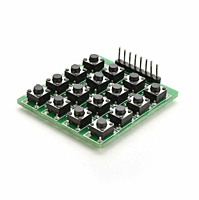




Push button keypad - 4x4
Product Details
Matrix Configuration: The buttons on a 4x4 keypad are organized in a matrix configuration, with each button represented by a unique combination of row and column connections. This matrix layout simplifies the wiring and interface with microcontrollers or digital circuits.
16 Buttons: A 4x4 keypad provides a total of 16 buttons for user input. These buttons are typically labeled with numbers (0-9) and additional symbols (# and *) for various input purposes.
Tactile Feedback: Push buttons on the keypad typically provide tactile feedback when pressed, allowing users to feel the button press and confirm the input.
Contact Mechanism: Beneath the buttons, there are conductive traces on a flexible membrane. When a button is pressed, it makes electrical contact between the corresponding row and column traces, registering a keypress.
Compact Design: These keypads are compact and space-efficient, making them suitable for applications with limited space.
Applications: 4x4 push button keypads are used in various applications that require user input, including security systems, door access control, telephones, vending machines, calculators, and industrial control panels.
Wiring: To use a 4x4 push button keypad, you'll typically connect the rows and columns of the keypad to digital input/output pins on a microcontroller or digital circuit. The microcontroller can then detect button presses by scanning the rows and columns.
Library Support: Depending on your microcontroller platform (e.g., Arduino, Raspberry Pi), there may be libraries or code examples available for interfacing with push button keypads, simplifying the integration into your projects.
Custom Labeling: Some keypads allow for custom labels or icons to be added to the buttons, making it easier to indicate their intended functions.


